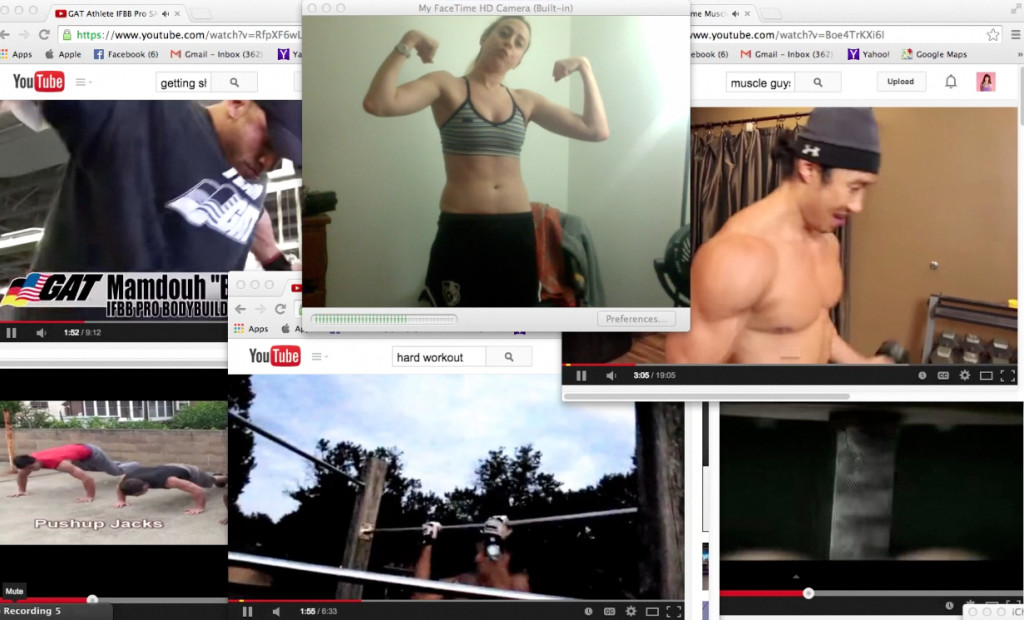
Snapshot from “penis envy,” hornylilfeminist.com
The work of performance artist Ann Hirsch considers the ways in which technology and mass media inform female identity and sexuality. Situating her performances within existing media landscapes and structures—reality television shows, YouTube, late-1990s AOL chat-rooms—she creates works that are equal parts sociological investigation and personal history, examining both the framing of women’s bodies within mass media and the ways in which the Internet has blurred the boundaries between performed and lived identities.
For her year-long performance “Scandalishious” (2008–09) she mined the YouTube “camwhore” subculture, creating a channel that documented the life of “Caroline,” a fictional college student whose videos were viewed over two million times. In 2010, Hirsch was a contestant on the VH1 reality-dating competition Frank the Entertainer in a Basement Affair, performing as “Annie,” an exaggerated version of herself intended to play into absurdist reality TV tropes. In 2013 Hirsch received a Rhizome commission to stage a two-person play, Playground—based on her experiences in AOL chat-rooms as an adolescent—in which she narrated a relationship with an older online boyfriend.
I spoke with Ann about the ways in which the Internet has transformed the notion of performance and documentation, and the problems implicit in using corporate platforms as an artist.
—RW
RW: You recently started a new web-based project, hornylilfeminist.com, where you’ve been playing with the idea of exposure on the web, both in terms of your body, but also aspects of your daily life and relationships, filtered through familiar social media forms such as Facebook newsfeed updates, YouTube vlog channels, and online wedding registries. What was the impetus for the site and its format?
AH: When I was doing “Scandalishious,” there was no collective Internet feminist voice. That was an era when no one was really talking about feminism [online]. But now it’s a thing. So in some ways, it’s kind of like “Scandalishious Part Two,” trying to find a voice for what it means to be a woman on the Internet today.
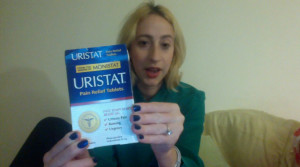
Image from “vaginal hygiene haul,” hornylilfeminist.com
RW: Some of the videos, like the “dental hygiene haul” or the “vaginal hygiene haul,” seem to parody existing YouTube video tropes—the “Sephora Haul,” for instance. Is that what you had in mind?
AH: It’s parody, but—like “Scandalishious”—it’s also real. I use all of these products [in the haul videos] and they’re important to me. But it’s very tongue-in-cheek as well, and specifically dealing with consumerism—how those kinds of videos play into the idea of everyone trying to be a commercial, a product placer, and how we have value in this world by promoting products. So I’m playing with that. All of my art is about pushing the boundaries of what I’m comfortable with and getting over things I’m ashamed about. That was why I decided I had to put my vagina on the Internet. I follow all these sexy Instagram girls, camgirls, and it’s all about a kind of allure, embodying sexy tropes. So I decided to put my body on the Internet in this kind of disgusting, real way.
RW: I’m wondering how you classify the work that you put online. For instance, when you make a video, or when you put a project up on a website, do you consider the work to be a performance, with, for instance, the video hosted online as documentation, or is the web-based video the work?
AH: It really depends. With hornylilfeminist.com, it is specifically that the video is online, in that website, because the work is about my body online and what it means for my body to be online in that way. And even the fact that it [uses the indexexhibit template] was a very considered choice: I see that as the pedestal for that work. Because it has this, like, cheesy art portfolio context. And with the Scandalishious videos, it was obviously important that those were online, that they were specifically on YouTube. But then with certain other projects, they’re just videos that happen to be online. So it really just varies project by project. The video that I made about the VH1 show [Frank the Entertainer], “Here For You”: that one truly is just a video that is housed on my website. And then there are some things that are just documentation of performances I did in a physical space.
RW: When I think about your work, and how you use web-based video, I find it very difficult to decide where the performance ends and the documentation begins. With “Scandalishious,” for instance, so much of the way you’re performing in those videos responds specifically to the YouTube context and the assumptions of a YouTube viewer.
AH: Yeah, those videos I wouldn’t say are documentation at all; it’s not like one video is equivalent to one performance or one piece. No, the whole thing is one piece, it’s the collection of all the videos, all the interactions I had, the video messages I exchanged, and that existence that I lived.
RW: You then did a scripted, one-woman play based on “Scandalishious,” which seemed to reverse the way we traditionally conceive of the relationship between performance and documentation, in which the live act is privileged as the real substance of the work and the documentation—the videos or photos of it—is secondary. With “Scandalishious,” it felt as if what happened on YouTube was the original, so to speak, and the live performance in the gallery functioned more like documentation, even if it was partially fictionalized.
AH: Yea, I think that’s really accurate. The original performance was me being on YouTube and living that [experience], so if you experienced me between 2008 and 2009 on YouTube, then you were part of the original performance, and then the play that I made about it, that is the documentation.
RW: I noticed that in your bios, you typically describe yourself first and foremost as a performance artist, but your work doesn’t necessarily privilege the live at all. You’ve done live performances, too, but there’s not an emphatic insistence on your body in the same space as the viewer in a particular moment. How do you define “performance artist” in an Internet context?
AH: Well I think that performance has changed so much because of the Internet. There’s this idea that everyone has a self, that we all have selfhood. And I think that was never true. But the Internet has kind of revealed that non-truth, it’s shown us that we have these splintered, fractured selves, because of the way we present ourselves online versus in real space, and then even online, the way we present ourselves on Instagram versus Twitter versus Facebook versus YouTube, or if we’re writing or making videos or whatever. So because of that, people have a greater awareness of how they’re performing in everyday life, so obviously performance art has needed to change to reflect that as well. So for me, being a performance artist is more about exaggerating the way that one performs these different facets of their lives: the way I perform in real life versus the way I perform online versus the way I perform on TV.
RW: What about with the reality TV show, Frank the Entertainer. I’m wondering where you think the work exists with that kind of project. Do you think of the show itself as a work of performance art by Ann Hirsch?
AH: When the show aired, I viewed that as documentation of my performance within that space. So the million or so people who tuned in every week were watching the documentation of my performance. Granted, it was documentation that I had absolutely no control over. So it was, I guess, a collaboratively made [performance.] And then the subsequent video works that I made from footage of the show are individual pieces, not documentation. But me being on the show I definitely view as a performance.
RW: In addition to performances where you’ve inserted yourself into existing situations or contexts, like Frank the Entertainer or YouTube, you’ve also done scripted performances or plays. What made you turn to a scripted theater format?
AH: With the “Scandalishious” performance piece, I call it a play, but I don’t know if I really consider it a play. I consider it truly [to be] a dramatization. Like, in the way that America’s Most Wanted is a dramatization of real events. The “Scandalishious” performance is a dramatization of real events. And I think that was just the best way for me to show people what I went through, and all the different things that you couldn’t see online. Like all the videos people sent me, the messages, the internal trauma that I had. But at the end of the day, it does come back to empathy, and humanizing. And I think for me, the easiest and the best way to do that is through narrative structures. It’s so easy to write off [these kinds of relationships] at a glance, but once I put it in some kind of narrative and build characters, people can empathize more.
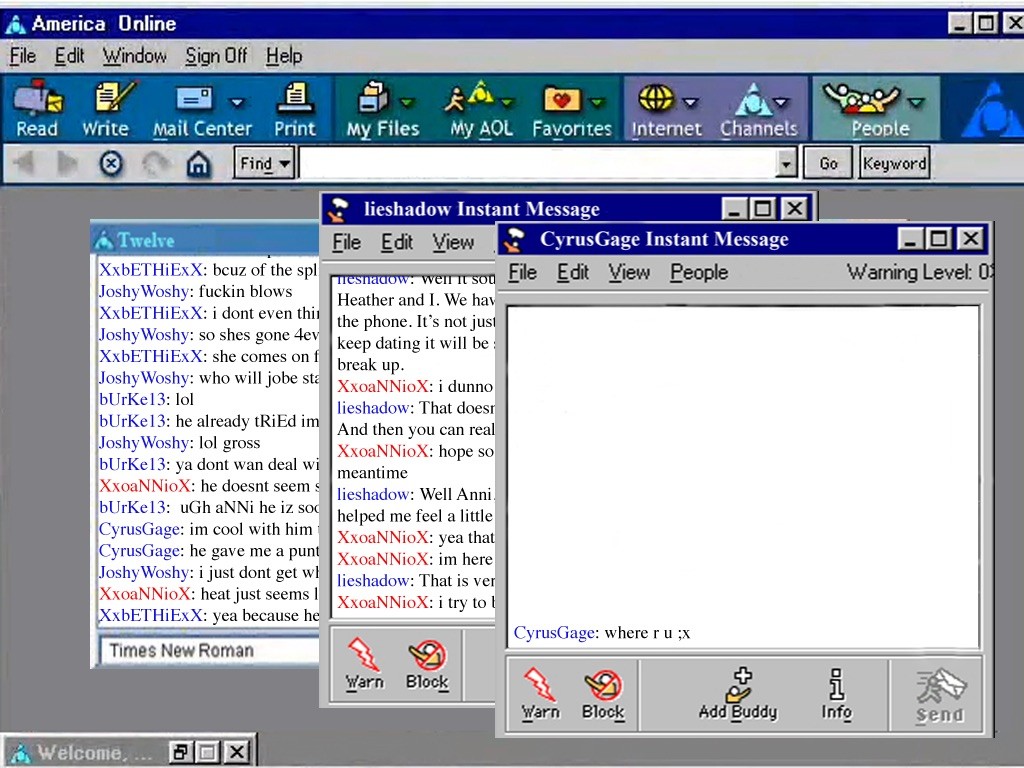
From Playground
RW: What about with the second play you did, Playground, which was originally staged at the New Museum, in which you weren’t actually performing on stage yourself, but directing actors?
AH: With Playground, I really call that a play, and I purposely used the theater—it’s a very traditional theater—and I was interested in comparing the “real space” with emotional space. So with that show, it begins [with the characters] just typing; that’s, in theory, the real space. And then as the show goes on, they enter theater space, emotional space, where they’re talking directly to one another and interacting with one another. But it only becomes more theatrical once the emotions [they’re expressing] are more intense. So as the emotions get more real, and the [characters] get more involved, then [what you see on stage] becomes more fake. So what I’m playing with is the question of what’s more real? The reality of them sitting at a computer typing or the emotions they’re feeling and the relationship that they’re grappling with, which, to outsiders might not seem real, might seem fake, because [they’re] just at a computer. So I was playing with the form of theater to get at those ideas and to really make true characters out of the two people.
RW: You also released an ebook, Twelve, commissioned by Klaus_ebooks, which is based on the same material as Playground. How do they relate to each other?
AH: They’re two different narrative formats. There’s only so much you can include in a play. If I turned the chat transcripts into a play, it would be a really fucking long play, like four hours. So with the ebook, I had the chance to really expand the story and give the bigger picture of how I even got involved with this person, and who these other people [mentioned] were. So it was just a way to give a larger context to the story.
RW: How much of those transcripts, if any, are “original?” Are they purely fictionalized, based on your memories, or did you have access to the actual chat logs from when you were in middle school?
AH: They were invented based on my memory. Again, it was a dramatization of real events. It’s like historical fiction.
RW: The ebook brings up another issue with your work: the question of censorship, and how working on the Internet often means relying on corporate platforms that are very much out of your hands. Because your work often addresses gender and sexuality, and you often use your body in your performances, you’ve repeatedly had problems with these platforms taking down your projects or flagging them as inappropriate, most recently with your webhost for hornylilfeminist.com, but also with the iTunes app store, which refused to let you distribute Twelve. What do you think about these kinds of restrictions? Is it interesting to you, negotiating these kind of issues, or is it a necessary evil that comes with working online?
AH: It’s a necessary evil. It’s very frustrating for me, because the only way people see my work is on the Internet, so I’m always just trying to get around these stupid rules. I don’t know any other artist whose web host refuses to host their website. That’s one problem I didn’t see coming. The first thing they said was that [they] can’t host porn because it attracts malware. And I said, “This isn’t porn, it’s art, you’re not going to have that problem here.” When I first looked at their terms of service, it didn’t say anything about adult content, and then after our first discussion I went back and they had literally added something about how Fat Cow [the web host] can take down anything at their sole discretion. All of the censorship, with the iTunes thing too, it always ends up being more work for me, more expensive for me, to get around these things. So this constant battle is just infuriating.
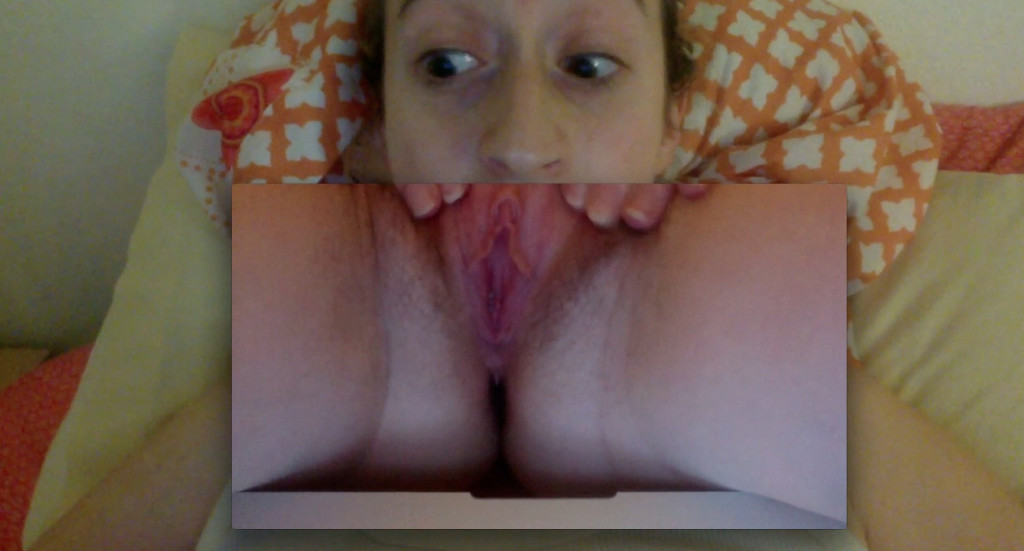
From “karaoke time,” hornylilfeminist.com.
With the ebook, were you expecting censorship from Apple?
AH: When we submitted it, we put the rating on it as 12+, because I thought it was kind of funny. And I thought, “oh, okay, maybe they won’t be happy with that rating, maybe they’ll make it adults only.” And then when they flagged it, I offered to change the rating to adults only, and I was really surprised when they said under no circumstances would [they] allow it, because, I’m sorry, it’s not that obscene. They have a strict no-porn policy, but it’s so clearly not porn.
So the way you and [Brian Droitcour, who curated the Klaus_ebooks series] chose to deal with that was by selling Twelve as an object, in jailbroken iPads, as editions. How did you feel about that as a solution?
AH: I think it’s the best solution we could come up with, but I wanted people to read it. The most important thing was visibility. Honestly, with all my work, the most important thing [for me] is that it’s visible and people can see and experience it. Some people were like, “Oh this is so great for you, it’s censored!”, but no one can read the work now. I would much rather have people able to see it easily by downloading it in the iTunes store.
Have these kinds of experiences with corporate platforms made you rethink the way you’re working? Not in terms of the content, but the choice to distribute it via the Internet or engage with web-based media?
AH: I just don’t see another way for me to distribute the work. Corporations control everything. You can’t be an artist and not be on the Internet. I don’t see any other alternative, because I don’t make objects. Otherwise, I’d just be making videos in my house and no one would see them.
.
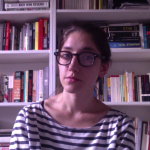 Rachel Wetzler is a New York-based writer and a doctoral candidate in art history at CUNY Graduate Center.
Rachel Wetzler is a New York-based writer and a doctoral candidate in art history at CUNY Graduate Center.
